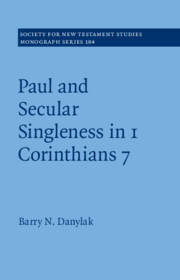Book contents
- Paul and Secular Singleness in 1 Corinthians 7
- Society for New Testament Studies Monograph Series
- Society For New Testament Studies Monograph Series
- Paul and Secular Singleness in 1 Corinthians 7
- Copyright page
- Contents
- Figures
- Tables
- Acknowledgements
- Abbreviations
- 1 Introduction and Methodology
- 2 The Demographic Shape of Secular Singleness
- 3 The Ideological Shape of Secular Singleness
- 4 The Context of 1 Corinthians 7
- 5 The Crux of 1 Corinthians 7
- 6 The Content of 1 Corinthians 7
- 7 Findings and Conclusions
- Appendix Individuals from the Egyptian Census Classified by Age
- Bibliography
- Ancient Sources Index
- Author Index
- Subject Index
1 - Introduction and Methodology
Published online by Cambridge University Press: 28 March 2024
- Paul and Secular Singleness in 1 Corinthians 7
- Society for New Testament Studies Monograph Series
- Society For New Testament Studies Monograph Series
- Paul and Secular Singleness in 1 Corinthians 7
- Copyright page
- Contents
- Figures
- Tables
- Acknowledgements
- Abbreviations
- 1 Introduction and Methodology
- 2 The Demographic Shape of Secular Singleness
- 3 The Ideological Shape of Secular Singleness
- 4 The Context of 1 Corinthians 7
- 5 The Crux of 1 Corinthians 7
- 6 The Content of 1 Corinthians 7
- 7 Findings and Conclusions
- Appendix Individuals from the Egyptian Census Classified by Age
- Bibliography
- Ancient Sources Index
- Author Index
- Subject Index
Summary
Paul’s discussion of marriage and singleness in 1 Corinthians 7 has long presented interpreters with an array of exegetical challenges. As William M. Ramsay once acknowledged, ‘There are not many passages in Paul’s writings that have given rise to so many divergent and incorrect views as this chapter.’1 A fundamental crux interpretum arises with the opening words of the chapter, ‘Now concerning the matters about which you wrote, it is good for a man not to touch a woman.’ Paul is clearly responding to previous non-extant correspondence of the Corinthians, but the reader must make some conjecture of what the situation was that prompted the Corinthians to write to Paul, and the primary nature of their concern, whether it concerned their marital status or sexual behaviour. A related question is whether the statement in 7:1b, ‘it is good for a man not to touch a woman’ reflects the Corinthians’ viewpoint, Paul’s viewpoint, both, or neither. A second major difficulty arises concerning the relationship of the issue that Paul responds to in 7:1 with the issue apparent in 7:25–26 that reflects very similar language. The latter may be an entirely separate concern or interconnected in some direct way to the prior. However readers navigate through the parts of the chapter, they are forced to proceed with some rudimentary reconstruction of what is prompting the overall discussion to which Paul responds. Such a reconstruction requires placing the Corinthians within some context with regard to how they thought about sexuality, singleness, and marriage and the motivations that prompted them to raise the questions they did with the apostle.
- Type
- Chapter
- Information
- Paul and Secular Singleness in 1 Corinthians 7 , pp. 1 - 40Publisher: Cambridge University PressPrint publication year: 2024



